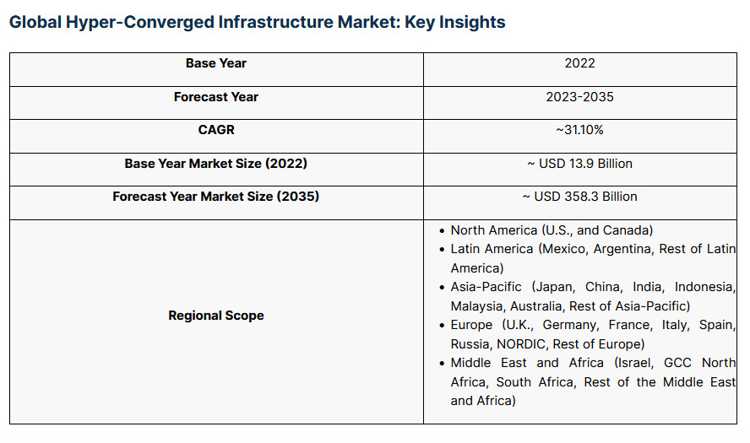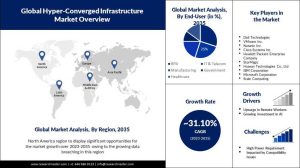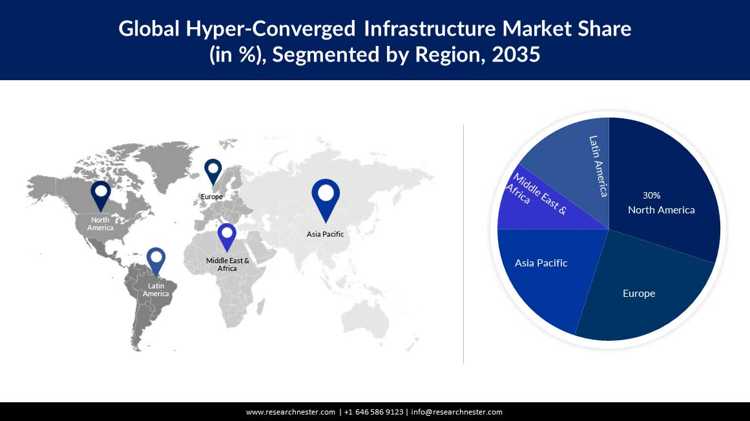HCI Market Projected to Reach $358 Billion by 2035 with CAGR of 31% from 2023 to 2035
In 2022 market size was $14 billion.
This is a Press Release edited by StorageNewsletter.com on September 19, 2023 at 2:02 pmPublished on April6, 2023 by Research Nester
In the paced world of technology, companies are always on the lookout for new ways to improve their IT systems.
Click to enlarge
The traditional data centers have gone through changes and become intricate environments that often require a dedicated team, for upkeep and management. That’s where the HCI market comes in – a solution that offers simplicity, scalability and cost efficiency. In this blog post we’ll take a dive into the realm of HCI exploring its growth, advantages, challenges and its crucial role in shaping the future of IT.
Rise of HCI
HCI is a method for managing data centers that integrates storage, compute, networking and virtualization into one system. By combining these elements, it eliminates the necessity for hardware components and streamlines infrastructure management. The HCI market has experienced remarkable growth in recent times.
Market overview According to a report by Research Nester the HCI market is projected to expand and reach a value of $358.3 billion by 2035 with a CAGR of 31.10% from 2023 to 2035. Furthermore, in 2022 the market size for HCI was recorded at $13.9 billion.
According to a report by Research Nester the HCI market is projected to expand and reach a value of $358.3 billion by 2035 with a CAGR of 31.10% from 2023 to 2035. Furthermore, in 2022 the market size for HCI was recorded at $13.9 billion.
Key players in the market include Dell Technologies, VMware Inc., Nutanix Inc., Cisco Systems Inc., Hewlett Packard Enterprise Company, StorMagic, Huawei Technologies Co., Ltd, IBM Corporation, Microsoft Corporation, and Scale Computing. These companies account for a significant portion of the market share and are continuously innovating to stay ahead of the competition.
-
February 2, 2022: Green panel has decided to implement the Dell EMC Vx Rail HCI in order to upgrade their data center and enhance efficiency in their manufacturing and business operations.
-
November 24, 2021: VMware has recently announced that they have again been recognized as a Leader in the Gartner Magic Quadrant for Hyperconverged Infrastructure Software marking their consecutive acknowledgment. Additionally, VMware has achieved the positioning on the Completeness of Vision axis.
Key market drivers and trends
-
Simplicity and ease of management: Simplifying data center management, HCI brings together storage, compute, networking and virtualization into one platform. This eliminates the requirement to handle hardware components and streamlines daily operations making IT infrastructure management less complex.
-
Edge computing: According to survey data it seems that businesses are planning to allocate around 31% of their IT budgets towards edge cloud computing in the coming 3 years. A significant portion 58% of decision makers in the field of mobility have already included edge computing in their plans since 2020. As edge computing gains importance many organizations are favoring HCI as a solution for managing remote and distributed IT environments. The design of edge HCI solutions addresses the challenges faced in edge locations, such as limited space and connectivity constraints.
-
Data protection and DR: Incorporating data security measures and contingency plans is a practice, in the field of Human Computer Interaction. These measures usually include automated backups and replication which are designed to safeguard the availability and integrity of data. By implementing these capabilities organizations can effectively minimize the risks associated with data loss and system downtime.
-
Hybrid and multi-cloud integration: Many companies opt for a combination of cloud (38% compared to 35% last year) or multi cloud strategy (35%) to make the most of various services scale up easily and ensure smooth business operations. Around 80% of organizations utilize 2 or more IaaS or PaaS providers. The field of HCI is constantly evolving to offer effortless integration with multi cloud environments. This empowers companies to enjoy the benefits of public cloud services while retaining control over their infrastructure.
-
AI and ML: Many HCI vendors are integrating intelligence AI and ML features into their businesses to improve resource allocation, enhance security measures and optimize predictive maintenance. This ultimately leads to increased efficiency. It has been noted that a significant 92% of top tier organizations are actively investing in AI initiatives. In terms of support, ML applications received a remarkable $29 billion in funding while ML platforms were granted $16 billion in investments during the year 2019.
Regional landscape and segmentation
The North American market is expected to see the highest growth in the market share of HCI compared to other regions by the end of 2035. This growth is driven by the increasing number of data breaches in this region and the efforts made by organizations to protect their data and invest in AI. Half (about 46%) of American businesses experienced a data breach in the past year but considering that there may be additional breaches that have not yet been discovered the actual number could be even higher. As a result, many enterprises in North America are focusing on improving their infrastructure security to enhance their hybrid cloud capabilities and advance their infrastructure strategy while maintaining strong security measures.
Global HCI market is segmented and analyzed for demand and supply by:
-
Component: Solutions, services.
-
Application: ROBO, virtual desktop infrastructure, data center consolidation, data protection and DR
-
End user: banking, financial services, and insurance BFSI, IT and telecom, manufacturing, government, and healthcare.
Out of which, it is expected that the banking, financial services and insurance (BFSI) industry will generate the highest revenue by 2035. This growth can be attributed to the increasing demand for storage and protection within this sector. Since January 2018, 999 data breaches have affected approximately 152 million records in USA alone. Consequently, ensuring data privacy has become a priority for the banking and finance sector.
Use cases
One of the most compelling use cases for HCI is VDI. With VDI users are able to access their desktops from a server, which can often be demanding on server resources. HCI provides a solution by offering a system that includes compute, storage and networking resources in one manageable package.
Another important application of HCI is in ROBO deployments. These environments typically have limited IT resources. Necessitate a solution that can be easily deployed and managed from a distance. HCI offers a simplified solution, for such scenarios minimizing complexity and enhancing overall efficiency.
Challenges of HCI
One of the difficulties with HCI is the risk of getting locked into a specific vendor. Once you’ve made an investment in a vendor’s solution, it can be quite challenging and costly to switch to another vendor. This limitation can restrict your choices. Make it harder to adapt in the long term. However, there are ways to address this concern. For instance, you can opt for a vendor that supports standards or utilize abstraction layers to separate your applications from the underlying infrastructure.
Another hurdle of HCI is dealing with potential complexities. As your environment expands and becomes intricate, managing and resolving issues can become quite challenging. To tackle this obstacle, it would be beneficial to consider leveraging automation tools and implementing practices, for configuration management. Additionally, having an understanding of your requirements and selecting a solution that meets those needs without unnecessary complications is crucial.
Conclusion
The HCI market is reshaping the world of IT by making data center management easier improving scalability and reducing costs. As companies prioritize transformation and agility, HCI will continue to be an important part of their IT strategies. To navigate this changing market successfully businesses need to assess their needs consider current trends and select HCI solutions that align with their long term goals. By doing they can fully utilize the potential of HCI and position themselves for future success in the constantly evolving technology landscape.
Resource:
Report: Global Hyper-Converged Infrastructure Market Size, Forecast, and Trend Highlights Over 2023 – 2035
















 Subscribe to our free daily newsletter
Subscribe to our free daily newsletter

